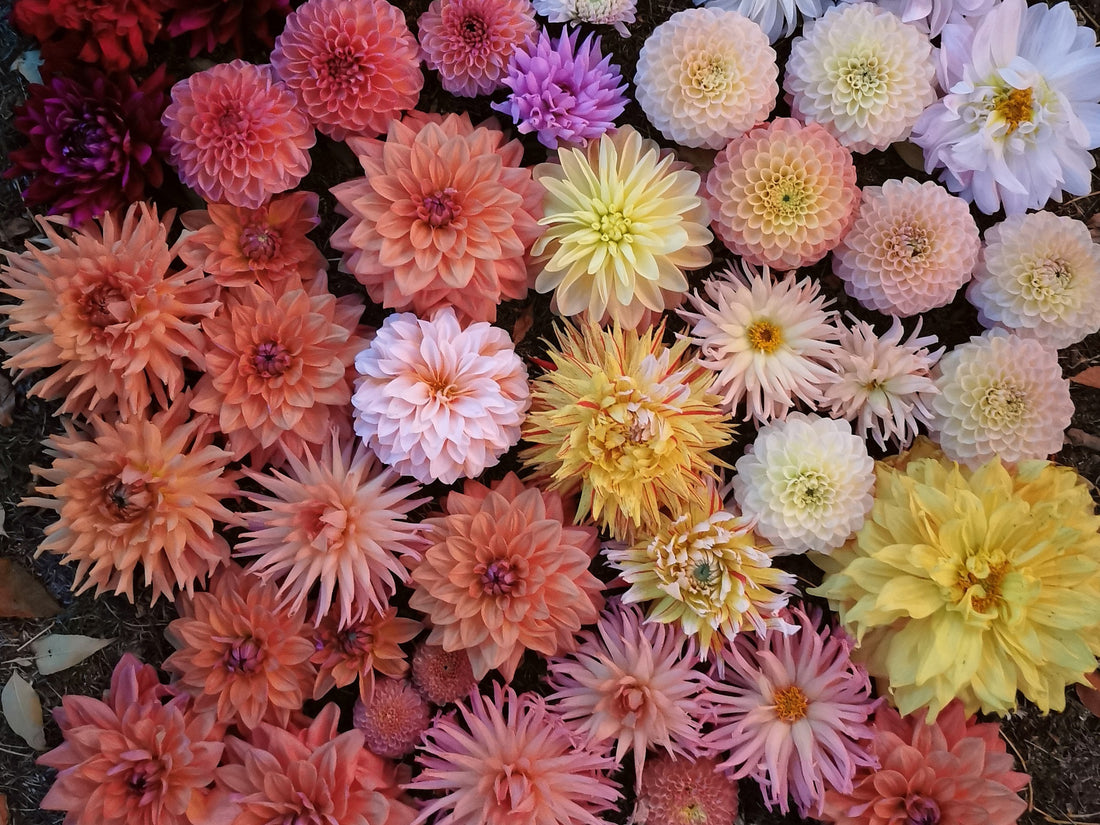
An Introduction to Dahlia Tubers
Welcome to the wonderful world of growing dahlias! In this post I hope to offer a quick introduction to dahlia tubers, a beginner's guide if you will. There are many different resources out there to help you get a start growing your own dahlias. Whether a home gardener with a few plants or a cut flower grower growing thousands, we have all acquired our own knowledge, experience and preferred methods for starting these beautiful plants.

Tubers come in all shapes and sizes, and to be honest it's a bit remarkable what grows from something that looks rather unassuming. The great thing about dahlia tubers is that the size and shape of the tuber is not important and plays no role in how large, abundant or healthy your dahlia plant will be. What matters most is the health of the tuber.


Is it firm and not mushy? A bit soft is ok, it happens with winter storage. Rehydrating them is not possible in storage, so don't bother misting with water or anything like that, in fact, that may just lead to rot so avoid additional moisture beyond natural air humidity. Be sure to pay close attention to the neck of each tuber. Some varieties have relatively short necks, some are almost non-existent. But a lot of tubers have long, slender necks that widen out to form the bulk of the tuber. The neck is naturally a delicate part of the tuber that if cracked or bent can lead to drying out of the neck. Without a strong, healthy neck the tuber can not "feed" the crown for bud growth which ultimately leads to the "death" of the tuber.
Are your tubers free of disease? There are two diseases that can be recognized in dahlias in their tuber form, crown gall and leafy gall. The diseases affecting dahlias deserve a blog post all on their own, which I intend to write within the coming weeks. It is important to be aware of these diseases to keep them from spreading within your own gardens and potentially to that of others by the sale or sharing of infected tubers. Both strains of gall have sadly been on the increase in recent years due to the influx of imported dahlia tubers. There is nothing wrong with purchasing imported tubers, it's how new varieties are introduced after all. But there is a level of responsibility that we as growers and gardeners must take to keep our gardens and fields free of as much disease as possible.
Is there a visible eye(s)? An eye is the growth point or bud on the crown of the tuber in which a dahlia plant will sprout from. When purchasing tubers, you want at minimum one eye, this will result in one sprout from your tuber. Having only one sprout, or eye, does not mean your tuber will only produce one flower. There are methods in which we use to get the most from our tubers, causing them to branch out and produce many blooms per tuber. This is another thing we will touch on at a later date. More often than not, a tuber will have multiple eyes, leading to multiple sprouts, it really just depends on the variety. Some varieties are very prolific and quick to "eye up" or sprout, while others may be a lot less productive and/or slow to start.



Once you receive tubers you've ordered come Spring, it's best to plant them straight away. Especially if eyes are starting to swell and/or roots or shoots are forming. If you can't get to your tubers right away I suggest storing them in the coolest location you can without freezing them. The ideal temperature for dahlia tuber storage is 4 to 10 degrees C. In a cooler in the coolest part of your basement will work, a cold storage room is great, or even in a fridge if you're in a pinch. Be sure to keep an eye on them, you don't want them to accidentally freeze or rot. Every grower is different in how they store and ship their tubers so with every order you get you're likely to receive them in a different storage medium. All orders from me will come with your tubers individually packaged in a sealed plastic bag of vermiculite, both items of which I encourage re-using if at all possible. I have relatively low humidity in my storage room so this is what works best for me for long-term storage. An increase in humidity may cause tubers packaged like this to rot, a bit of surface mold can always be wiped away, but rot can not be fixed. So check your tubers often if you plan to store them before planting. And should you purchase tubers from me, or anyone else, and they come fully enclosed, be sure to open the bag, or unwrap them so they can get air.



This was a very quick rundown on the basics of dahlia tubers. There is so much more that can be said and I hope to be able to add to this throughout this year. Touching on important bits such as disease, planting and care, learning how to take cuttings, what to do once frost hits, and perhaps the biggest one, dividing and storing for winter. If there's anything you'd like to know more about, please don't hesitate to reach out, I'm always happy to help! Happy Planting!
Angelina

